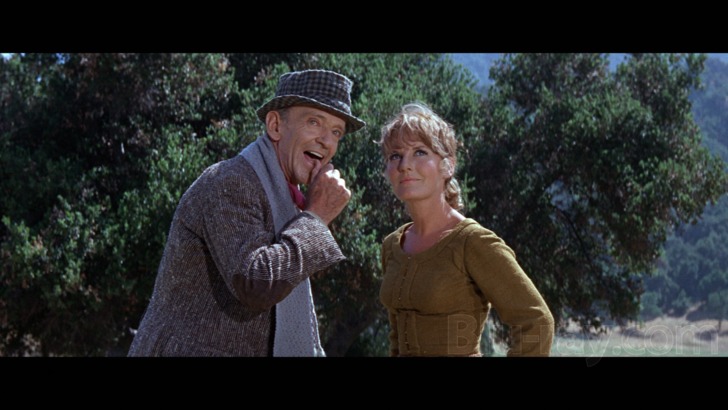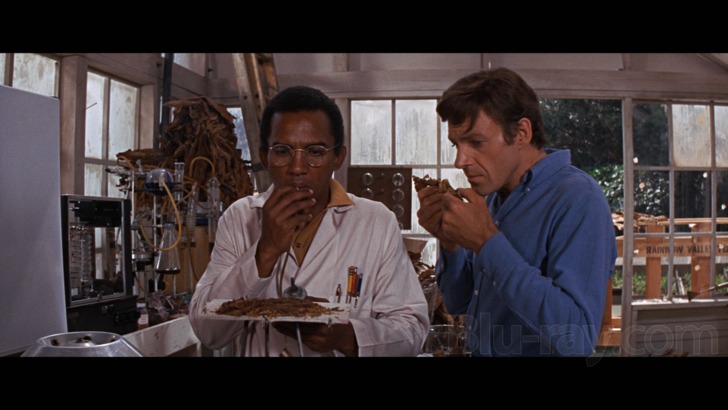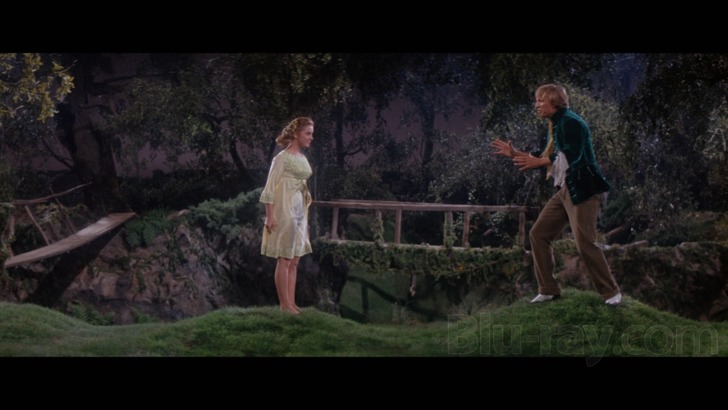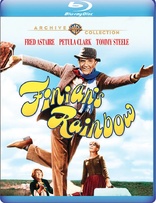Finian's Rainbow Blu-ray Movie
HomeFinian's Rainbow Blu-ray Movie 
Warner Archive CollectionWarner Bros. | 1968 | 145 min | Rated G | Mar 07, 2017
Movie rating
6.7 | / 10 |
Blu-ray rating
| Users | 4.5 | |
| Reviewer | 3.0 | |
| Overall | 3.0 |
Overview
Finian's Rainbow (1968)
An Irish rogue plants a stolen crock of leprechaun gold in the soil near Fort Knox to reap what he thinks will be a rich harvest. In tow are his spirited daughter, a lovestruck leprechaun and a bigoted Southern senator transformed by misbegotten magic.
Starring: Fred Astaire, Petula Clark, Tommy Steele, Don Francks, Keenan WynnDirector: Francis Ford Coppola
| Musical | Uncertain |
| Romance | Uncertain |
| Comedy | Uncertain |
| Fantasy | Uncertain |
Specifications
Video
Video codec: MPEG-4 AVC
Video resolution: 1080p
Aspect ratio: 2.40:1
Original aspect ratio: 2.35:1
Audio
English: DTS-HD Master Audio 5.1 (48kHz, 24-bit)
Subtitles
English SDH
Discs
Blu-ray Disc
Single disc (1 BD)
Playback
Region A, B (C untested)
Review
Rating summary
| Movie | 2.5 | |
| Video | 4.5 | |
| Audio | 4.5 | |
| Extras | 2.5 | |
| Overall | 3.0 |
Finian's Rainbow Blu-ray Movie Review
Lucky Charms
Reviewed by Michael Reuben March 10, 2017Finian's Rainbow was the first studio film directed by Francis Ford Coppola after his
apprenticeship with Roger Corman, and the future director of the Godfather Trilogy and
Apocalypse Now leapt at the opportunity to enter
the ranks of legitimate Hollywood. Coppola
knew the score of the 1957 Broadway musical by heart, but as he would later lament, he should
have paid more attention to the show's book, which worked on stage but was clunky and
overstuffed when transferred to the screen without major revision. Instead of stripping down the
play and streamlining the narrative for the camera, Coppola tried to remedy its flaws by piling on
still more plot devices. (In his defense, as a newcomer he probably didn't have the clout to
demand a script overhaul.) The result was an unwieldy, overlong contraption that was mildly
successful in its day due to the casting of Fred Astaire in what would be his last musical, but
Finian has aged badly. The original stage show, by contrast, provided a lively and satisfying
revival on Broadway as recently as 2009—a tribute to the quality of the underlying material.
Finian has its charms, which include the incomparable grace of Fred Astaire, still light on his
feet at the age of 69, as well as pop star Petula Clark, who surprised American critics and
audiences by demonstrating that she really did know how to act. The memorable songs by
composer Burton Lane (On a Clear Day You Can See
Forever) and lyricist E.Y. Harburg (The
Wizard of Oz) remain as catchy as ever. For those who remember Coppola's Finian fondly, the
Warner Archive Collection has provided a first-rate Blu-ray presentation.

The Finian of the title is Finian McLongergan (Astaire), who has left his native Ireland to seek his fortune in America, dragging along his dutiful daughter, Sharon (Clark), whose homesickness inspires one of the show's most famous songs ("How Are Things in Glocca Morra?"). Finian's gimmick for striking it rich is emblematic of the story's fanciful spirit: He has stolen a pot of gold from the leprechauns, and he intends to plant it in the soil near Fort Knox, which he believes to have magical properties that will yield a bounteous crop of new gold. But Finian doesn't realize that his theft from the leprechauns —or "borrowing", as Finian insists—is devastating to the sprightly spirits, who are turning mortal without their precious metal. The leprechauns have dispatched one of their number, Og (Tommy Steele), to recover the missing gold. He catches up with Finian in the fictional Rainbow Valley, Missitucky, where the cheerful Irishman has just rented a plot of land from tobacco farmer Woody Mahoney (Don Francks).
On this fairy tale foundation, screenwriters Harburg and Fred Saidy (adapting their original play) erect a baroque structure encompassing everything from a romantic triangle—when both Og and Woody fall for Sharon McLongergan—to social commentary, as Woody and the other inhabitants of Rainbow Valley battle Senator Billboard Rawkins (Keenan Wynn) for control of their land. Besides being greedy, Senator Rawkins is also an unapologetic racist, which makes it a serious problem when an accidental overflow of magic from the leprechauns' buried gold transforms him into an African-American. Accusations of witchcraft threaten Sharon's life, and the only person who can exonerate her is Woody's mute sister, Susan (Barbara Hancock), though she cannot say what she knows (and apparently can't write it either). Og and his magic eventually save the day, but at the price of turning Og into a mortal—which the former leprechaun doesn't mind so much when he realizes that he loves Susan even more than Sharon ("When I'm Not Near the Girl I Love"). Three guesses on whether Susan recovers the power of speech.
Such whimsical material requires a delicate touch to sustain the fantasy, but the young Coppola became preoccupied with making Finian "realistic" (whatever that means in a film where a main character is a leprechaun). Instead of cutting down the sequences that drag on the narrative—which is true of almost every dialogue scene —he adds new ones, such as an unnecessary subplot about the efforts of Woody and his botanist friend, Howard (Al Freeman Jr.), to cross-breed tobacco with mint, thereby producing naturally mentholated tobacco. Where the stage play opens on the citizens of Rainbow Valley, establishing both the locale and its atmosphere, Coppola begins with an extended montage of Finian and Sharon trekking across America, a decision he would later attribute to his frustration at not being allowed to shoot on location. It's a weirdly assembled montage for someone purportedly striving for "realism", as the McLongergans traipse from New York's Statue of Liberty to San Francisco's Golden Gate Bridge, then backtrack to the Grand Canyon and Mt. Rushmore before finally returning east to the vicinity of Fort Knox. Scenery rules the day, and geography be damned.
The whole of Finian is directed with the same lack of focus reflected in that opening sequence, resulting in a lethargic pace even while the cast is expending frantic energy to enliven the proceedings. (Tommy Steele's Og is especially overcooked, as if the actor were still on stage projecting his performance to the balcony.) The musical interludes remain the highlight of Finian, recapturing some of the ethereal quality that this fable of magical blarney requires. Astaire's long-time collaborator, Hermes Pan, choreographed most of the dance moves before Coppola fired him, a decision the director now says he regrets. For Coppola, Pan represented the old Hollywood style against which the young filmmaker was rebelling, but Finian was an ill-chosen project for an insurgent talent to attempt something new. In the DVD commentary recorded almost forty years later, Coppola repeatedly says that a director's essential task is to make the film come alive on screen, but Finian does so only intermittently.
(Note that WAC's Blu-ray of Finian contains the full "roadshow" version, complete with overture, intermission/entr'acte and exit music.)
Finian's Rainbow Blu-ray Movie, Video Quality 

Finian's Rainbow was shot by Philip C. Lathrop, whose credits extend from comedy (The Pink Panther) to drama (Days of Wine and Roses) to genre pictures (Earthquake). Consistent with its now-standard practice, the Warner Archive Collection commissioned a new scan for the film's Blu-ray debut, which was performed at 2K by Warner's Motion Picture Imaging facilty, using an interpositive of recent vintage. After color correction and cleanup, the image on WAC's 1080p, AVC-encoded Blu-ray is impressive, showcasing the verdant greens and other bright colors of the soundstages and locations that the production used to create Rainbow Valley. The whimsical costume design, which is less historically accurate than theatrically eccentric, can be appreciated in all its detail, as well as the elaborate sets that make up the town and its surroundings. You can see every wrinkle in Fred Astaire's face, which shocked moviegoers of the period, for whom the youthful hoofer of Top Hat and Swing Time remained permanently frozen in memory. Fine detail falls off slightly in long shots, especially when the camera is moving, but this appears to be inherent in the source (and would certainly be consistent with the behavior of anamorphic lenses from that period). Nighttime blacks and shadows are properly rendered, and the film's grain pattern is finely resolved. WAC has mastered Finian at its usual high bitrate, here 34.99 Mbps.
Finian's Rainbow Blu-ray Movie, Audio Quality 

Finian's Rainbow was released to theaters in both mono (for 35mm prints) and a six-track mix to accompany a 70mm blow-up. The lossless DTS-HD MA 5.1 track on WAC's Blu-ray has been sourced from the magnetic masters for the six-track mix. Perhaps reflecting its mono origins, the mix remains front-oriented, with the surrounds limited to expansion of the sonic space. Stereo separation is most apparent in the orchestrations scored by Ray Heindorf (The Music Man), who also contributed incidental underscoring. The dialogue and vocals are clearly reproduced, as are the essential sound effects that help "sell" some of the fanciful happenings onscreen. The dynamic range is wide for a film of this vintage, and the fidelity and clarity are excellent.
Finian's Rainbow Blu-ray Movie, Special Features and Extras 

The extras have been ported over from Warner's 2005 DVD of Finian's Rainbow.
- Commentary with Director Francis Ford Coppola: Coppola does great commentaries, but this isn't one of his best. Watching his youthful effort nearly forty years later, the director is obviously troubled by its shortcomings and says repeatedly that he would like to take a print of the film and cut it down. Still, interesting tidbits are tucked among the laments: stories about how the director was hired, his impressions of Warner Brothers in the late Sixties, tales of working with Astaire, and even an account of how a young George Lucas ended up assisting his former film school classmate, which ultimately led to their collaboration on American Graffiti, written and directed by Lucas and produced by Coppola. The single best anecdote is when Lucas describes accompanying Astaire to a performance of the musical Hair, which the elderly star just couldn't "get", even after Coppola tried to explain it to him.
- Francis Ford Coppola: DVD Introduction (480i; 1.78:1, enhanced; 5:26): Many of the commentary's highlights also appear in this short introduction, which leads directly into the film, as Coppola continues speaking while the overture plays. The film continues with the commentary switched on.
- The World Premiere of Finian's Rainbow (480i; 1.33:1; 25:37): This made-for-TV promotional feature focuses on the film's New York premiere. Host Lee Phillip interviews performers Al Freeman Jr., Barbara Hancock, Tommy Steele, Don Francks and Fred Astaire, as well as director Francis Ford Coppola. Petula Clark supplies a separately filmed contribution.
- Theatrical Trailer (1080p; 2.35:1; 2:58): "Look to the rainbow! Look to Fred Astaire! Look to Petula Clark!"
Finian's Rainbow Blu-ray Movie, Overall Score and Recommendation 

Coppola has never had much luck with musicals, as confirmed by his financially disastrous
experimental film, One from the Heart. Even when
the genre was still popular, it was hard to get
it right, and the fact that Warner Brothers would entrust such a demanding project to an as-yet
unproven director speaks to the studios' desperation to discover a winning formula in the era of
Easy Rider and The Last Picture Show. The filmed version of Finian doesn't
begin to capture the
charm of the stage original, but it has some interesting performances, and the musical sequences
are rescued by the quality of the songs. WAC's Blu-ray presentation is recommended on its
technical merits; the film itself is an acquired taste.
Similar titles
Similar titles you might also like

Xanadu 4K
1980

How to Succeed in Business Without Really Trying
1967

Hello, Dolly!
Fox Studio Classics
1969

Flower Drum Song
1961

Brigadoon
1954

Viva Las Vegas
50th Anniversary
1964

On Moonlight Bay
Warner Archive Collection
1951

Hairspray
2-Disc Shake and Shimmy Edition
2007

One Touch of Venus
1948

Stormy Weather
Limited Edition to 3000 - SOLD OUT
1943

At Long Last Love
1975

Neptune's Daughter
Warner Archive Collection
1949

State Fair
1945

The Gang's All Here
Limited Edition to 3000
1943

Cry-Baby
1990

The Pirates of Penzance
1983

Funny Lady
Limited Edition to 3000 - SOLD OUT
1975

Good News
Warner Archive Collection
1947

Cover Girl
Limited Edition to 3000 - SOLD OUT
1944

Kiss Me Kate 3D
1953
